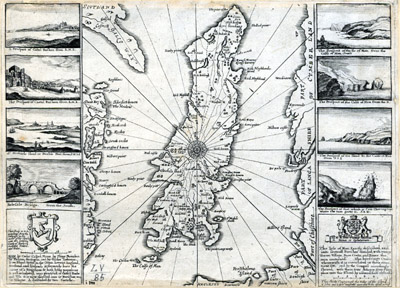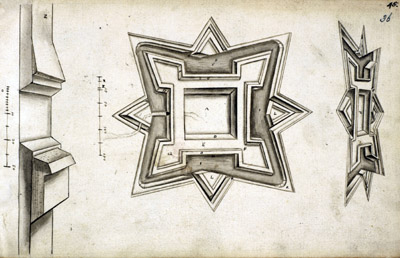 |
Kerroogarroo Fort
Isle of Man, UK
|
|
 |
Constructed: 1645
Used by: English Royalists
Conflict in which it participated:
English Civil War
Also known as: Ballachurry Fort,
Fort Loyal
|
There aren't a whole lot of starforts left from the English Civil War. Plenty were built, but they were earthworks, and we all know what happens to earthworks over a period of 400 years, if nobody's taking an active role in their upkeep.
The Isle of Man is a wee island (32 miles long, 14 miles at its widest) that sits smack in the middle of the Irish sea, more or less equidistant from England, Ireland and Scotland. There are plenty of fortifications all over this isle, primarily hill forts dating to the Bronze and Iron ages, with delightful names such as Towlfoggy, Burroo Ned and Niarbyl. The delightfulness of such names comes to us courtesy of the language of Manx, which was the Isle of Man's primary language until England elbowed its way into such things. |
 |
|
|
Manx is a close cousin to Gaelic which, while beautiful when spoken, is disturbingly discordant to the English-speaking eye in print...which is why we're talking about a fort named Kerroogarroo. At least it's not called Cronk Mooar ny Traagh (another hill fort).
|
 The Isle of Man exactly described, and into severall Parishes divided, with every Towne, Village, Baye, Creke and River therein conteyned, 1656, by Daniel King and Wenceslaus Hollar. It's big, it's beautiful, but y'know what I do not see, no matter how hard I squint? Kerragarroo Fort. Maybe it was a secret starfort! The Isle of Man exactly described, and into severall Parishes divided, with every Towne, Village, Baye, Creke and River therein conteyned, 1656, by Daniel King and Wenceslaus Hollar. It's big, it's beautiful, but y'know what I do not see, no matter how hard I squint? Kerragarroo Fort. Maybe it was a secret starfort! |
 |
England and Scotland fought over the Isle of Man through the first half of the 14th century, until England took it for good in 1346. This was during the reign of King Edward III (1312-1377), and henceforth, the Lord of Mann would oversee the little island in the name of the crown.
Starting in the mid-14th century, the Isle was Lorded by the Earls of Derby, and in 1642 James Stanley (1607-1651) became the Seventh Earl of Derby and therefore Lord of Mann. These were troubling times in England, as King Charles I (1600-1649) and England's Parliament were not getting along with one another, to the extent that war betwixt the Royalist Cavaliers and Parliamentarian Roundheads was imminent. Stanley didn't have a notable opinion on the matter prior to his ascention to Earldom, but once war was declared in 1642, he devoted himself to the king. |
|
I have a concern regarding the year in which Ballachurry Fort, as it was initially known, was built. James Stanley, the Seventh Earl of Derby (known locally as Yn Stanlagh Mooar, The Great Stanley) seems to be universally credited with the construction of this lovely starfort, but he didn't become the Earl until 1642, and most of the sources I've seen about the fort date it at 1640. His father William Stanley (1561-1642), the Sixth Earl of Derby, did reportedly hand his estates over to his son some years before he died...but if James was unconcerned with the brouhaha leading up to the start of the English Civil War (1642-1651), why would he be building such a fort on the Isle of Man? Perhaps he reasoned that war was coming, and there would be a need to defend the island from somebody, come what may? One source sets the year of Kerroogarroo Fort's initial construction at 1645, which seems more likely.
|
All sources agree that this starfort was never completed, but what was eventually built was at least a defensible portion of an earthwork starfort with a wooden stockade running along the top of its walls, around 50 yards wide, all surrounded by a moat...by no means a massive fortress, but probably quite an obstacle to any who might come across it!
But who would have come across it? It's a bit of a mystery as to why this fort was placed where it was, far from the Isle of Man's population centers at Douglas and Castletown, and close to no river or even a road. The Isle of Man's northern plain is reported to have been substantially more waterlogged in the 1640's than it is today, so it's possible that an army that had landed on the island's northern shore and was marching to the Isle of Man's only real cities to the south, would have had to pass right by this fort, which would have been on higher and drier land...but it's also possible that this was intended to be a secret starfort, a secure storage facility holding food and ammunition for the island's notional defenders.
We don't know, because James Stanley never explained his starfort-placement reasoning to anyone: He was too busy fighting for the king on the mainland, leaving the Isle of Man's defenses under the command of his wife (Lady Derby) and a brother (Brother Derby). Stanley was an able battlefield commander, but things went sideways for the Seventh Earl of Derby in 1651, when he was captured by Parliamentarian forces, found guilty of treason, and beheaded.
|
 |
 An absolutely dreamy drawing that appeared in a report commissioned by the postwar Lord of Mann, Thomas Fairfax. It is unlikely that Kerroogarroo Fort ever looked anything near this fantastic: This was what Fairfax would have liked an upgraded Kerroogarroo Fort to look like, and was likely just copied from a military textbook. An absolutely dreamy drawing that appeared in a report commissioned by the postwar Lord of Mann, Thomas Fairfax. It is unlikely that Kerroogarroo Fort ever looked anything near this fantastic: This was what Fairfax would have liked an upgraded Kerroogarroo Fort to look like, and was likely just copied from a military textbook. |
|
The Parliamentarian Navy soon surrounded the Isle of Man, and those left in charge in the ex-Earl's absence hastened to surrender. While the majority of the island's defenses were turned over to the Roundheads without a fuss, the starfort of our current interest was garrisoned when, on October 21, 1651, a Parliamentarian force under the command of local politician Illiam Dhone (1608-1663) arrived to take control of the fort...and the fort's commander, a Major William Stanley (related to the dear-departed Earl? Unclear), refused to cooperate.
|
|
 |
The two opposing parties bellowed impoliteitudes at one another through the barred gate, until Ewan Curghey, an enraged Roundhead, stomped off and set fire to the nearby home of John McSayle, one of the fort's defenders. This was enough to cause many of the garrison to desert their posts and flee, and Ballachurry Fort was taken. Which all sounds kind of silly, but it was elegant proof that, even if unfinished, this fort was enclosed enough to be defensible, at least until people on the outside started utilizing the 17th-century weapon of mass destruction.
The period following the execution of King Charles I (January 30, 1649) until the restoration of King Charles II (May 29, 1660) is known as the English Interregnum. It sounds like a pretty unpleasant time, in that many Puritan values were imposed on England, including the outlawing of gambling and the theater, and the suppression of such holidays as Easter and Christmas, for goodness' sake.
During this turbulent time Sir Thomas Fairfax (1612-1671) served as Lord of Mann, and commissioned a report about the island. This report included several lovely drawings of the sights, animals and major structures on the Isle of Man, and is today the earliest surviving pictoral history of the island. Most importantly for our interests, however, is the idealized drawing above of what a proper starfort looked like at that time, which appeared in the report by way of illustrating the general idea of Ballachurry Fort...which around this period became known as Karroogarroo Fort. |
|
Why the name change? Our starfort was also known as Fort Loyal during the war, and it certainly couldn't be called that in the enlightened (if stifingly boring) post-Monarchy age...and assumedly the name Ballachurry had some connection to the previous Lord of Mann, so changed the name had to be. Today there is a (very) small community called Kerroogarroo centered just a smidge to the fort's northwest. This community appears to comprise a small number of far-flung farms; is it named for the fort, or was the fort named for it? Chime in here please, Kerroogarrooians. And while you're chiming, could you please let us know what a "kerroogarroo" is? Google Translate identifies the word "kerroogarroo" as Somali, with a translation of, "kerroogarroo."
After Kerroogarroo Fort had been noted by whomsoever had put together the report for Fairfax in the 1650's, it pretty much ceased to historically exist, with the need to defend the Isle of Man from anyone ceasing to exist right along with it. Today a purposeful bee-line path from its northern bastion to its southern bastion, where a suspiciously perfect-looking square clearing awaits, is the only apparent evidence that anyone has visited Kerroogarroo Fort in the past 370 years.
Many thanks to starfort enthusiast Winston Smith, who alerted us to Kerroogarroo Fort!
|
|
|
|
|
|
 |




